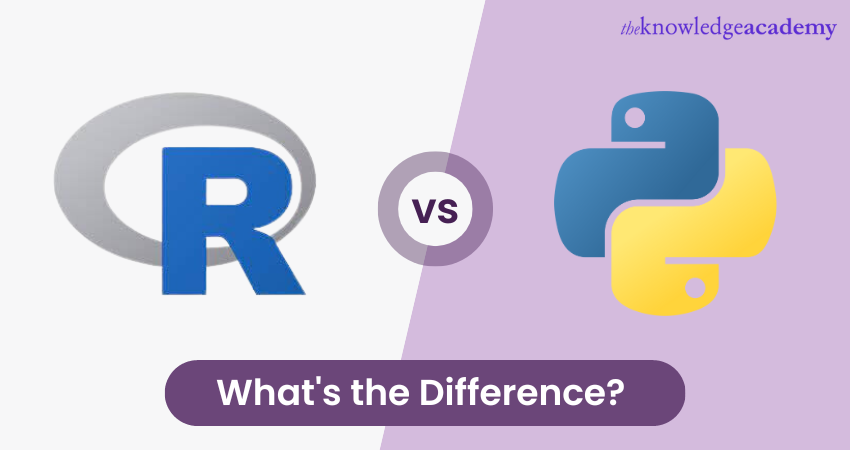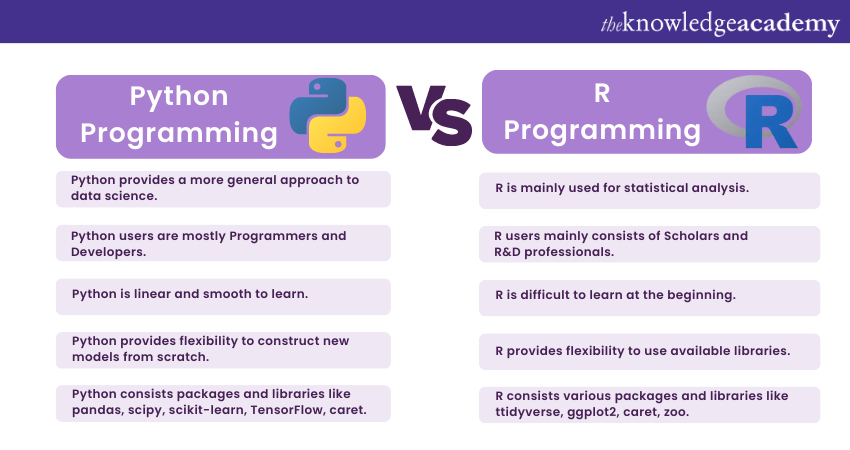We may not have the course you’re looking for. If you enquire or give us a call on 01344203999 and speak to our training experts, we may still be able to help with your training requirements.
We ensure quality, budget-alignment, and timely delivery by our expert instructors.

In programming languages, two names stand out for their remarkable contributions to data science, analytics and coding: R Programming Language vs Python. Both have garnered immense popularity over the years and are widely used by professionals. However, developers often find themselves at a crossroads while selecting the right programming language.
So, if you want to know which programming language can fit your requirements, you have come to the right place. Read this blog for a detailed comparison R Programming Language vs Python. Also, explore their syntax, capabilities and more.
Table of Contents
1) An introduction to R and Python
2) Difference between Python and R programming
a) Syntax and structure of R and Python
b) Data manipulation and analysis
c) Visualisation
d) Performance and speed
e) Community and support
3) Use cases and applications
4) Future trends and predictions
5) Conclusion
An Introduction to R and Python
‘R’ is an open-source programming language primarily used as data analysis and statistical software. R was born out of the language ‘S’, which was developed by John Chambers and his colleagues in the 1970s. Ross Ihaka and Robert Gentleman created R in the early 1990s. The primary motivation behind R's development was to have an open-source language tailored for statistical computing and graphics.
Python is another programming language used in web and software development, mathematics, system scripting etc. Guido van Rossum introduced this programming in the late 1980s, and its first version, Python 0.9.0, was released in 1991. It aimed to provide a versatile and readable programming language that emphasised code readability and simplicity.
Get hands on experience in using R programming language efficiently. Register for our R Programming Course now!
Difference between Python and R programming
While both Python and R programming are widely used programming languages, they have certain differences that make one stand out from the other. So, let’s take a quick look at the differences between R Programming vs Python:

Syntax and structure of R and Python
R and Python have distinct syntax and coding conventions, attracting different communities of developers. R is known for its expressive syntax that enables concise coding for statistical operations. It uses a combination of functional and object-oriented programming paradigms.
On the other hand, Python follows a more structured and easily readable syntax with indentation-based block delimiters. Its code often reads like plain English, making it approachable for beginners.
Data manipulation and analysis
Both Python and R programming offer powerful tools for data manipulation and analysis, but they have different approaches. R boasts a rich ecosystem of packages, including dplyr and tidyr, designed specifically for data wrangling and transformation. These packages allow users to perform complex data manipulations with ease. It also shines when it comes to statistical modelling and hypothesis testing, making it a top choice for statisticians and data scientists.
Python, too, has impressive libraries for data manipulation, such as Pandas, which is widely used in the data science community. However, its flexibility extends to Machine Learning and Deep Learning libraries like Scikit-learn and TensorFlow, making it a versatile language for data analysis and AI-driven projects.
Visualisation
R's ggplot2 package is renowned for its visually stunning and customisable plots. It provides a high level of control over plot aesthetics, making it a favourite among data visualisation enthusiasts.
While Python's matplotlib library offers a wide range of plotting options, and when combined with seaborn, it becomes a powerful toolkit for data visualisation. Additionally, Python's interactive visualisation libraries like Plotly and Bokeh allow for interactive and web-ready visualisations.
Performance and speed
Performance is a crucial factor in choosing a programming language for computationally intensive tasks. R's performance can sometimes be slower compared to Python, especially for large datasets or computationally heavy operations. However, with advances in optimisation and the use of packages like data tables, R's speed has significantly improved.
Python, being a general-purpose language, benefits from its efficient execution speed. Moreover, libraries like NumPy and Pandas are built with performance in mind, providing fast and efficient data processing capabilities.
Community and support
The size and activity of a programming language's community can greatly influence the availability of learning resources, packages, and community support. R has a strong and vibrant community, especially in the field of statistics and data analysis.
The Comprehensive R Archive Network (CRAN) hosts thousands of packages, making it a treasure trove of resources for R developers. Additionally, various forums and online communities provide ample support for newcomers.
Python's community is one of the largest and most active in the programming world. The Python Package Index (PyPI) houses an extensive collection of packages catering to a wide range of applications. Its vast community ensures that developers can find help easily and stay updated with the latest trends and developments.
Learn how to build your video games in Python. Join our Python Game Development Training With Pygame Course now!
Use cases and applications
When it comes to R Programming Language vs Python use cases and applications, both of them find their applications in different domains, making them suitable for various purposes. Let's have a detailed look at the use cases and applications of both programming languages:
R's use cases and applications
The following are the use cases and applications of the R programming language:
a) Statistical analysis: R is widely recognised as the go-to language for statistical analysis. Its vast collection of statistical functions and libraries, along with its intuitive syntax, make it the preferred choice for researchers and statisticians. R is extensively used in academia and research to analyse and interpret data, conduct hypothesis testing, and build predictive models.
b) Data visualisation: Researchers, Data Analysts, and Data Journalists frequently use R to create compelling charts, graphs, and interactive visualisations.
c) Bioinformatics: R plays a significant role in the field of bioinformatics, where it is used to interpret biological data and analyse, such as DNA sequencing, gene expression, and protein structure. Bioinformaticians leverage R's statistical tools and visualisation capabilities to extract meaningful patterns from large biological datasets.
d) Econometrics: Economists and Financial Analysts use R to perform econometric modelling, time series analysis, and forecasting. R's specialised packages, such as plm for panel data analysis and forecast for time series forecasting, are invaluable resources in econometric research.
Python's use cases and applications
The following are the use cases and applications of Python programming language:
a) Web development: Frameworks like Django and Flask allow developers to create scalable web applications efficiently. Python's ease of use has contributed to the growth of web frameworks and applications.
b) Automation and scripting: Python is widely used for automating repetitive tasks, system administration, and scripting. Python's straightforward syntax and platform independence make it a popular choice for automation projects.
c) Game Development: Python's versatility extends to game development, where it is often used for scripting and prototyping. Libraries like Pygame provide the necessary tools to create 2D games and simulations.
d) Data Engineering: Python's capabilities are not limited to data analysis; it also excels in data engineering tasks. Its ability to integrate with big data frameworks like Apache Spark and Apache Hadoop makes it a valuable asset for Data Engineers working on large-scale data processing projects.
Future trends and predictions
The world of programming is ever-evolving, and R and Python are no exceptions. Data Scientists and analysts with proficiency in R are often sought after in industries where statistical analysis plays a crucial role. On the other hand, Python Developers are in high demand across various domains due to Python's extensive applications.
Both Python and r programming are likely to continue their growth in the coming years. R will maintain its strong presence in academia and research, while Python's versatility and community support will continue to drive its popularity across various industries.
Conclusion
We hope that after reading the blog, you have got the distinction between R Programming language vs Python. Both are powerful programming languages with unique strengths, and their applications cater to diverse domains. R's excellence in statistical analysis and data visualisation is used widely in academia and various scientific fields. On the other hand, Python's versatility extends its applications to Data Science, Machine Learning, Artificial Intelligence. and more.
Become a Python master with our Python Data Science Training!
Frequently Asked Questions
Upcoming Programming & DevOps Resources Batches & Dates
Date
 R Programming Course
R Programming Course
Fri 28th Feb 2025
Fri 4th Apr 2025
Fri 27th Jun 2025
Fri 29th Aug 2025
Fri 24th Oct 2025
Fri 5th Dec 2025






 Top Rated Course
Top Rated Course



 If you wish to make any changes to your course, please
If you wish to make any changes to your course, please


